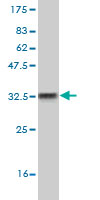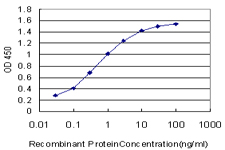BLR1 Antibody (monoclonal) (M01)
Mouse monoclonal antibody raised against a partial recombinant CXCR5.
- 产品详情
- 实验流程
- 背景知识
Application
| WB, E |
|---|---|
| Primary Accession | P32302 |
| Other Accession | NM_001716 |
| Reactivity | Human |
| Host | mouse |
| Clonality | monoclonal |
| Isotype | IgG2a Kappa |
| Clone Names | 2C1 |
| Calculated MW | 41955 Da |
| Gene ID | 643 |
|---|---|
| Other Names | C-X-C chemokine receptor type 5, CXC-R5, CXCR-5, Burkitt lymphoma receptor 1, Monocyte-derived receptor 15, MDR-15, CD185, CXCR5, BLR1, MDR15 |
| Target/Specificity | CXCR5 (NP_001707, 1 a.a. ~ 56 a.a) partial recombinant protein with GST tag. MW of the GST tag alone is 26 KDa. |
| Dilution | WB~~1:500~1000 E~~N/A |
| Format | Clear, colorless solution in phosphate buffered saline, pH 7.2 . |
| Storage | Store at -20°C or lower. Aliquot to avoid repeated freezing and thawing. |
| Precautions | BLR1 Antibody (monoclonal) (M01) is for research use only and not for use in diagnostic or therapeutic procedures. |
For Research Use Only. Not For Use In Diagnostic Procedures.
Provided below are standard protocols that you may find useful for product applications.
BACKGROUND
This gene was identified as a gene specifically expressed in Burkitt's lymphoma and lymphatic tissues. The protein encoded by this gene is predicted to be a seven transmembrane G protein- coupled receptor and belongs to the CXC chemokine receptor family. BLC, a B-lymphocyte chemoattractant, was identified to be a specific ligand for this receptor. Studies of this gene and its mouse conterpart strongly suggest the essential function of this gene in B cell migration and localization within specific anatomic compartments, such as follicles in lymph nodes as well as in spleen. Two alternatively spliced variants of this gene exist.
REFERENCES
Variation at the NFATC2 Locus Increases the Risk of Thiazolinedinedione-Induced Edema in the Diabetes REduction Assessment with ramipril and rosiglitazone Medication (DREAM) Study. Bailey SD, et al. Diabetes Care, 2010 Jul 13. PMID 20628086.PI3Kp110-, Src-, FAK-dependent and DOCK2-independent migration and invasion of CXCL13-stimulated prostate cancer cells. El Haibi CP, et al. Mol Cancer, 2010 Apr 22. PMID 20412587.Serum BLC/CXCL13 concentrations and renal expression of CXCL13/CXCR5 in patients with systemic lupus erythematosus and lupus nephritis. Lee HT, et al. J Rheumatol, 2010 Jan. PMID 19955043.Gene-centric association signals for lipids and apolipoproteins identified via the HumanCVD BeadChip. Talmud PJ, et al. Am J Hum Genet, 2009 Nov. PMID 19913121.Clinical and biological significance of CXCR5 expressed by prostate cancer specimens and cell lines. Singh S, et al. Int J Cancer, 2009 Nov 15. PMID 19610059.
终于等到您。ABCEPTA(百远生物)抗体产品。
点击下方“我要评价 ”按钮提交您的反馈信息,您的反馈和评价是我们最宝贵的财富之一,
我们将在1-3个工作日内处理您的反馈信息。
如有疑问,联系:0512-88856768 tech-china@abcepta.com.























 癌症的基本特征包括细胞增殖、血管生成、迁移、凋亡逃避机制和细胞永生等。找到癌症发生过程中这些通路的关键标记物和对应的抗体用于检测至关重要。
癌症的基本特征包括细胞增殖、血管生成、迁移、凋亡逃避机制和细胞永生等。找到癌症发生过程中这些通路的关键标记物和对应的抗体用于检测至关重要。 为您推荐一个泛素化位点预测神器——泛素化分析工具,可以为您的蛋白的泛素化位点作出预测和评分。
为您推荐一个泛素化位点预测神器——泛素化分析工具,可以为您的蛋白的泛素化位点作出预测和评分。 细胞自噬受体图形绘图工具为你的蛋白的细胞受体结合位点作出预测和评分,识别结合到自噬通路中的蛋白是非常重要的,便于让我们理解自噬在正常生理、病理过程中的作用,如发育、细胞分化、神经退化性疾病、压力条件下、感染和癌症。
细胞自噬受体图形绘图工具为你的蛋白的细胞受体结合位点作出预测和评分,识别结合到自噬通路中的蛋白是非常重要的,便于让我们理解自噬在正常生理、病理过程中的作用,如发育、细胞分化、神经退化性疾病、压力条件下、感染和癌症。







